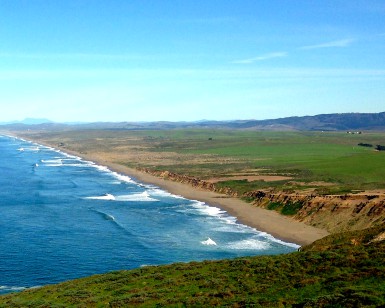San Rafael, CA – The County of Marin has taken another step to protect its coastline, inlets, and bays – and therefore also its agricultural lands, tourism, air quality, recreation, biodiversity, and quality of life - with an ordinance requiring local voter approval before any development of onshore facilities that would support offshore oil and gas exploration.
 The County is closer to giving voters the power to approve or disapprove future development of oil and gas exploration facilities in Marin County.
The County is closer to giving voters the power to approve or disapprove future development of oil and gas exploration facilities in Marin County.Gaining the Marin County Board of Supervisors’ support on August 18, the ordinance will undergo a second reading August 25 and, if passed, become effective September 25. A simple majority of registered voters would have to support a County zoning change to reverse an existing countywide ban on such development and allow for onshore support facilities to be constructed in the future.
The action is in response to what the County believes is an increased threat to locate these types of facilities in Marin and brings it into alignment with counties up and down California’s coastline. Any new or expanded onshore infrastructure that would support offshore oil and gas exploration will be banned unless the voters approve.
“By approving this ordinance, the Board of Supervisors has taken another step in protecting our coastline and coastal economies that add so much to the quality of life here in Marin,” said Supervisor Dennis Rodoni, who represents West Marin.
Supervisor Kate Sears, who served on a Board subcommittee with Rodoni on the topic, credited the County Counsel staff for clarifying the impacts of oil and gas facilities on natural resources.
“While these facilities are currently prohibited,” Sears said, “this ordinance is important because it puts voters in the driver’s seat for any future decision making regarding these types of facilities and adds a layer of protection for the beauty of our coastline, the health of our wetlands, and the quality of our air and water.”
In its research, the County found that construction and operation of onshore support facilities could:
- impede public access to the coastline and bay shoreline;
- imperil valuable marine resources that are required by the California Coastal Act to be maintained and enhanced;
- disrupt the biological productivity of our coastal waters and bay waters and the conditions required to sustain healthy populations of all species of marine organisms; and
- threaten numerous industries reliant on a healthy coastline and ocean ecosystem.
The counties of Sonoma, San Francisco, Santa Cruz, San Mateo, Monterey, San Luis Obispo, San Diego, Mendocino, and Humboldt have similar ordinances.
Marin has a long track record of protecting the environment as well as fully prioritizing renewable energy. For example, in 2010 the County led the effort to launch the first community choice aggregation program in California, which resulted in the creation of MCE Clean Energy. The County purchases all its electricity from renewable wind and solar resources through MCE Clean Energy, and it has installed more than 1.1 megawatts of solar arrays on its own facilities.